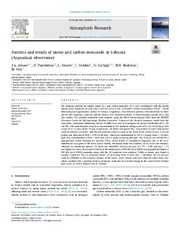Mostrar el registro sencillo del ítem
Patterns and trends of ozone and carbon monoxide at Ushuaia (Argentina) observatory
| dc.contributor.author | Adame, J.A. | |
| dc.contributor.author | Puentedura, Olga | |
| dc.contributor.author | Gómez, L. | |
| dc.contributor.author | Condori, Lino Fabián | |
| dc.contributor.author | Carbajal Benítez, Gerardo | |
| dc.contributor.author | Barlasina, María Elena | |
| dc.contributor.author | Yela, Margarita | |
| dc.date.accessioned | 2021-03-11T20:06:06Z | |
| dc.date.available | 2021-03-11T20:06:06Z | |
| dc.date.issued | 2021-06 | |
| dc.identifier.citation | J.A. Adame, O. Puentedura, L. Gómez, L. Condorí, G. Carbajal, M.E. Barlasina, M. Yela, Patterns and trends of ozone and carbon monoxide at Ushuaia (Argentina) observatory, Atmospheric Research, Volume 255, 2021, 105551, ISSN 0169-8095, https://doi.org/10.1016/j.atmosres.2021.105551 | es |
| dc.identifier.issn | 0169-8095 | |
| dc.identifier.uri | http://hdl.handle.net/20.500.12160/1524 | |
| dc.identifier.uri | https://doi.org/10.1016/j.atmosres.2021.105551 | |
| dc.identifier.uri | https://www.sciencedirect.com/science/article/pii/S0169809521001034 | |
| dc.description | Artículo publicado en la Revista Atmospheric Research, Volumen 255, 15 Junio 2021. | es |
| dc.description.abstract | The behavior patterns for surface ozone (O3) and carbon monoxide (CO) were investigated with the hourly mixing ratios registered for nine years (2010 to 2018) at the GAW-WMO (Global Atmospheric Watch – World Meteorological Organization) station of Ushuaia (Argentina). Two behavior patterns were identified for these species after applying a criterion. Specific periods were analyzed in detail, in which nitrogen dioxide (NO2) was also studied. The weather conditions were explored using the ERA5 meteorological fields from the ECMWF (European Centre for Medium-Range Weather Forecasts). Outputs of the chemical transport model from the Copernicus Atmosphere Monitoring Service (CAMS) were used to investigate the spatial distribution of O3, CO and NO2. The more frequent scenario is characterized by the unaltered mixing ratios of O3 and CO for days, with values of 10–15 ppb and 60–70 ppb, respectively, and below 200 ppt for NO2. This pattern occurred with intense westerly airflows associated with the low-pressure system located in the south of the Pacific Ocean. A second pattern was observed in 45.8 ± 3.4% of the days, which was characterized by low O3 mixing ratios (~12 ppb), high NO2 concentrations (above ~3000 ppt) and CO peaks exceeding 400 ppb. This scenario was defined by a high-pressure system blocking the westerly winds, which results in atmospheric stagnation and in the accumulation of trace gases in the lower layers. Finally, the annual trend was explored; no O3 trend was obtained, although an unexpected upward CO trend was identified, with an increase of 1.75 ± 0.49 ppb year 1. To investigate its causes, the annual evolution of the temperature at 850 hPa level (T850) and geopotential height at 500 hPa level (Z500) anomalies along with the CO emissions were analyzed. While no trends were found in weather conditions, the CO emissions showed an increasing trend of 4.4% year 1; therefore, the CO increase could be attributed to the emission changes. In the future, warm climate with more frequent anticyclonic situations, together with a growing trend in emissions, could lead to a drastic change in the current levels of these trace gases, in remote regions such as Ushuaia. | es |
| dc.language.iso | en_US | es |
| dc.publisher | Elsevier | es |
| dc.rights | info:eu-repo/semantics/embargoedAccess | es |
| dc.subject | SURFACE OZONE | es |
| dc.subject | CARBON MONOXIDE | es |
| dc.subject | NITROGEN DIOXIDE | es |
| dc.subject | MAXDOAS | es |
| dc.subject | ERA5 | es |
| dc.subject | COPERNICUS | es |
| dc.subject | USHUAIA | es |
| dc.title | Patterns and trends of ozone and carbon monoxide at Ushuaia (Argentina) observatory | es |
| dc.type | Artículo | es |
| dc.rights.license | No posee licencia CC | es |
